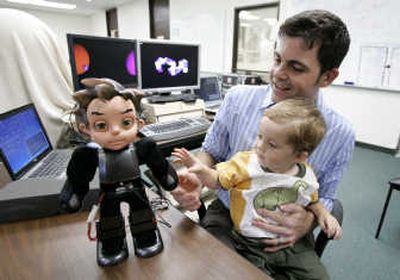The new face of robotics

RICHARDSON, Texas — David Hanson has two little Zenos to care for these days.
There’s his 18-month-old son Zeno, who prattles and smiles as he bounds through his father’s cramped office.
Then there’s the robotic Zeno. It can’t speak or walk yet, but has blinking eyes that can track people and a face that captivates with a range of expressions.
At 17 inches tall and 6 pounds, the artificial Zeno is the culmination of five years of work by Hanson and a small group of engineers, designers and programmers at his company, Hanson Robotics. They believe there’s an emerging business in the design and sale of lifelike robotic companions, or social robots. And they’ll be showing off the robot boy to students in grades 3-12 at the Wired NextFest technology conference Thursday in Los Angeles.
Unlike clearly artificial robotic toys, Hanson says he envisions Zeno as an interactive learning companion, a synthetic pal who can engage in conversation and convey human emotion through a face made of a skin-like, patented material Hanson calls frubber.
“It’s a representation of robotics as a character animation medium, one that is intelligent,” Hanson beams. “It sees you and recognizes your face. It learns your name and can build a relationship with you.”
It’s no coincidence if the whole concept sounds like a science-fiction movie.
Hanson said he was inspired by, and is aiming for, the same sort of realism found in the book “Supertoys Last All Summer Long,” by Brian Aldiss. Aldiss’ story of troubled robot boy David and his quest for the love of his flesh-and-blood parents was the source material for Steven Spielberg’s film “Artificial Intelligence: AI.”
He plans to make little Zenos available to consumers within the next three years for $200 to $300.
The company, which has yet to break even, was also buoyed by a $1.5 million grant from the Texas Emerging Technology Fund last October. The fund was created by Gov. Rick Perry in 2005 to improve research at Texas universities and help startup technology companies get off the ground.
Hanson concedes it’s going to be at least 15 years before robot builders can approach anything like what seems to be possible in movies. Zeno the robot remains a prototype.
During a recent demonstration, Zeno could barely stand and had to be tethered to PCs that told it how to smile, frown, act surprised or wrinkle its nose in anger.
Robotics, Hanson believes, should be about artistic expression, a creative medium akin to sculpting or painting. But convincing people that robots should look like people instead of, well, robots, remains a challenge that robot experts call the “uncanny valley” theory.
The theory posits that humans have a positive psychological reaction to robots that look somewhat like humans, but that robots made to look very realistic end up seeming grotesque instead of comforting.
“Nobody complains that Bernini’s sculptures are too darn real, right? Or that Norman Rockwell’s paintings are too creepy,” Hanson said. “Well, robots can seem real and be loved too. We’re trying to make a new art medium out of robotics.”